牛津译林版(2019)必修第二册 Unit 2 Be sporty, be healthy-Extended reading课件(18张ppt)
文档属性
| 名称 | 牛津译林版(2019)必修第二册 Unit 2 Be sporty, be healthy-Extended reading课件(18张ppt) | 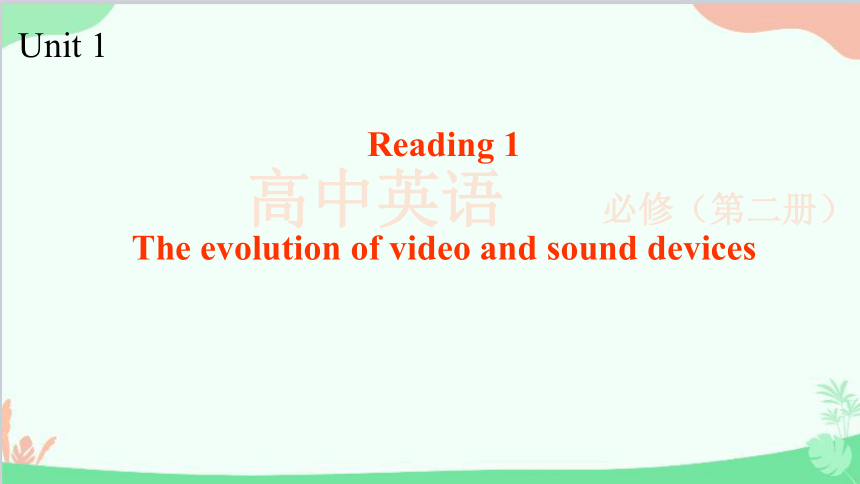 | |
| 格式 | ppt | ||
| 文件大小 | 651.0KB | ||
| 资源类型 | 教案 | ||
| 版本资源 | 牛津译林版(2019) | ||
| 科目 | 英语 | ||
| 更新时间 | 2022-09-22 18:36:11 | ||
图片预览

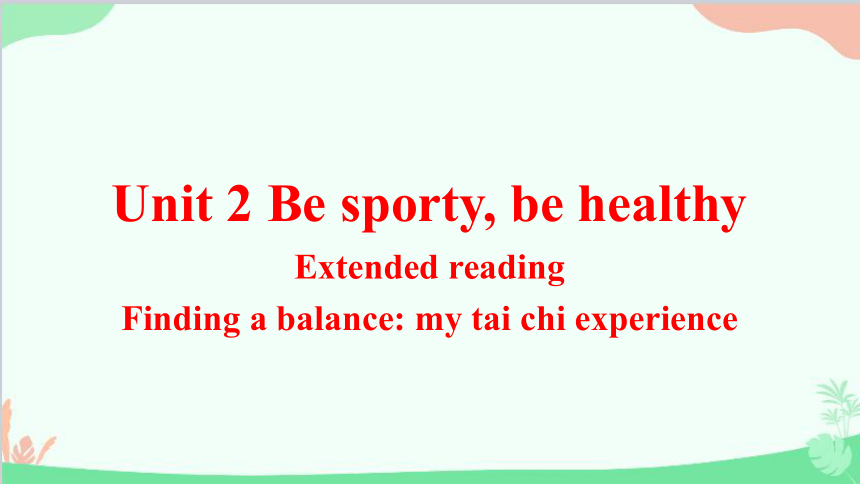
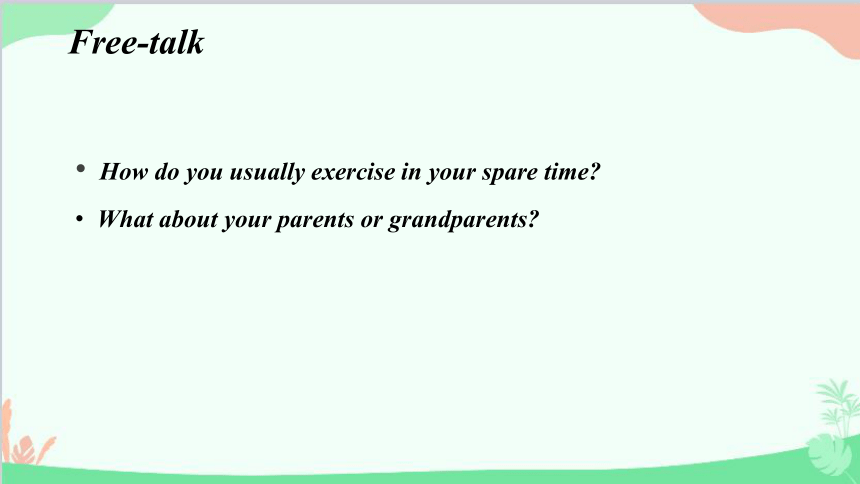
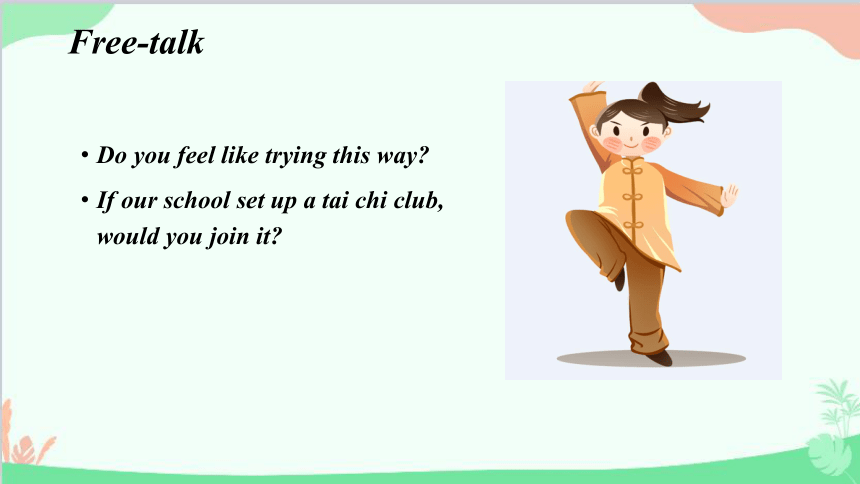
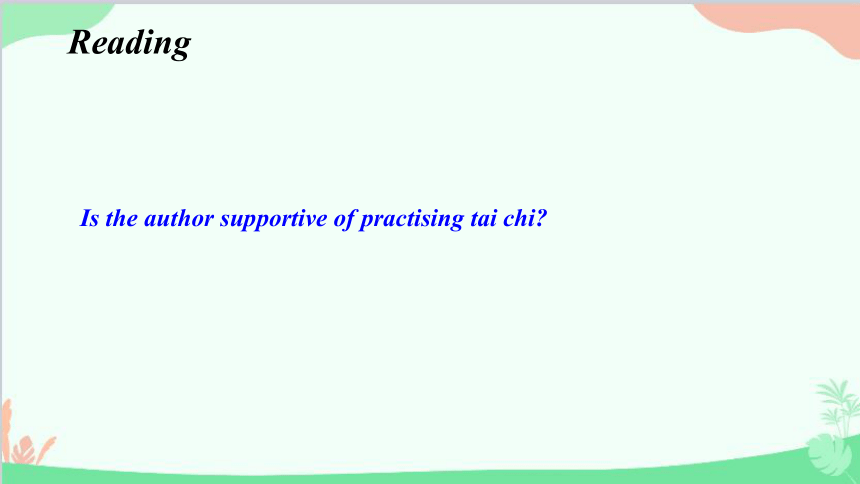
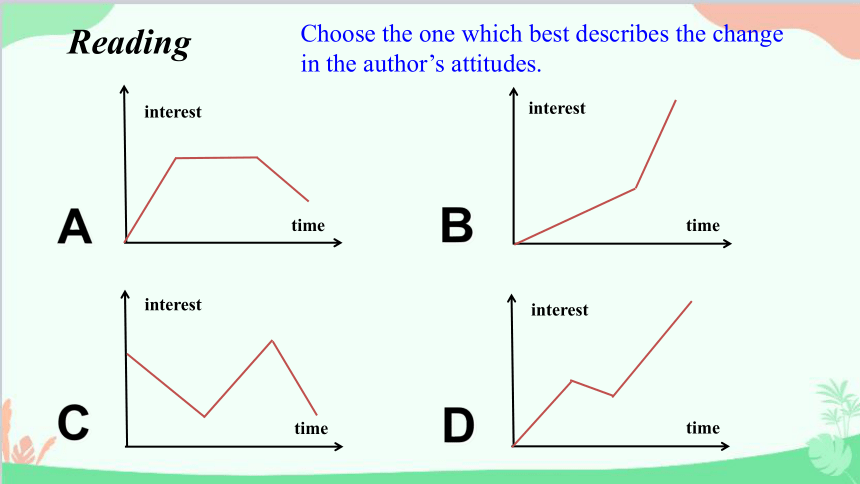
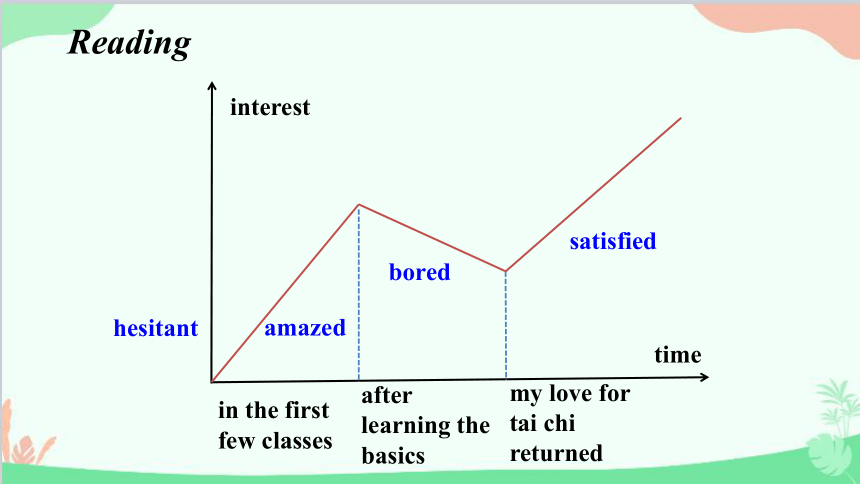
文档简介
(共19张PPT)
Unit 1
Reading 1
The evolution of video and sound devices
高中英语 必修(第二册)
Unit 2 Be sporty, be healthy
Extended reading
Finding a balance: my tai chi experience
Free-talk
How do you usually exercise in your spare time
What about your parents or grandparents
Do you feel like trying this way
If our school set up a tai chi club, would you join it
Free-talk
Is the author supportive of practising tai chi
Reading
time
interest
time
interest
time
interest
time
interest
A
B
C
D
Choose the one which best describes the change in the author’s attitudes.
Reading
amazed
hesitant
in the first few classes
after learning the basics
my love for tai chi returned
bored
satisfied
interest
time
Reading
What was the author’s tai chi experience like
Write about it in your own words using the information from the article.
Consolidation
The author used to think tai chi was just for old people, and he hesitated about practising it at first. Gradually, he came to find tai chi more and more interesting and eventually fell in love with it. Furthermore, he began to understand the culture behind tai chi and was able to apply its philosophy to his everyday life.
You can write like this!
Consolidation
Compare and figure out the similarity.
White crane spreading its wings
Golden rooter standing on one leg
Parting the wild horse mane
Grasping sparrow tail
They both use the moves to keep balance.
Reading
Read Paragraph 2 and understand the history of tai chi.
Reading
Zhang Sanfeng, a 13th-century Taoist, was said to have invented tai chi after drawing inspiration from a fight between a snake and a bird.
Chen Wangting, a 17th-century master of Chinese martial arts, was said to have developed tai chi based on martial arts skills.
Essence of tai chi
Root
C_______________ (1)
Forwards & ____________ (4)
Up & ____________ (5)
Left & ____________ (6)
Breathing in & ____________ (7)
K__________ (8)
…
…
…
Y__ (2)
Y___ (3)
hinese philosophy
in
ang
backwards
down
right
eep balance
Reading
breathing out
The Chinese culture behind tai chi
How do we understand the sentence there is no shadow without light Why is it used here
Where there is light, there is shadow. The writer uses this example to explain the equal and opposite forces which make up the world can’t live without the other.
Exploration
Can you make up more sentences to explain the philosophy of yin and yang
There is no right without wrong.
There is no fairness without unfairness.
There is no white without black.
There is no day without night.
There is no success without failure.
Exploration
The Chinese culture behind tai chi
How do you understand the philosophy between the opposites How do you put it in your life
Just as the passage says, the world is made up of opposite forces and neither of them can be independent of the other. The opposites always keep balance and no one could break it. Like days and nights, it always goes from one situation to the opposite. For example, if one fails sometimes, he should never give up. As long as he changes the way he does and thinks, things would be changed. On the contrary, if one succeeds, he shouldn’t be too proud. Keep calm or he will lose.
Discussion
The Chinese culture behind tai chi
Do you think tai chi will get more popular among teenagers Why or why not
Yes, I think tai chi will definitely become more popular among teenagers, because I believe young people are becoming more aware of the importance of physical and mental health. Tai chi is great because it helps with both. This should make it a good choice for teenagers who want to take up an exercise. Also, as a traditional Chinese form of exercise, tai chi will probably get a lot of support from the government, schools and other bodies.
Discussion
The Chinese culture behind tai chi
1. Write an essay (120 words) to introduce and promote tai chi as
a Chinese cultural ambassador.
2. Finish the workbook.
Homework
Homework
1. Read this article aloud.
2. Finish the workbook.
谢 谢
Unit 1
Reading 1
The evolution of video and sound devices
高中英语 必修(第二册)
Unit 2 Be sporty, be healthy
Extended reading
Finding a balance: my tai chi experience
Free-talk
How do you usually exercise in your spare time
What about your parents or grandparents
Do you feel like trying this way
If our school set up a tai chi club, would you join it
Free-talk
Is the author supportive of practising tai chi
Reading
time
interest
time
interest
time
interest
time
interest
A
B
C
D
Choose the one which best describes the change in the author’s attitudes.
Reading
amazed
hesitant
in the first few classes
after learning the basics
my love for tai chi returned
bored
satisfied
interest
time
Reading
What was the author’s tai chi experience like
Write about it in your own words using the information from the article.
Consolidation
The author used to think tai chi was just for old people, and he hesitated about practising it at first. Gradually, he came to find tai chi more and more interesting and eventually fell in love with it. Furthermore, he began to understand the culture behind tai chi and was able to apply its philosophy to his everyday life.
You can write like this!
Consolidation
Compare and figure out the similarity.
White crane spreading its wings
Golden rooter standing on one leg
Parting the wild horse mane
Grasping sparrow tail
They both use the moves to keep balance.
Reading
Read Paragraph 2 and understand the history of tai chi.
Reading
Zhang Sanfeng, a 13th-century Taoist, was said to have invented tai chi after drawing inspiration from a fight between a snake and a bird.
Chen Wangting, a 17th-century master of Chinese martial arts, was said to have developed tai chi based on martial arts skills.
Essence of tai chi
Root
C_______________ (1)
Forwards & ____________ (4)
Up & ____________ (5)
Left & ____________ (6)
Breathing in & ____________ (7)
K__________ (8)
…
…
…
Y__ (2)
Y___ (3)
hinese philosophy
in
ang
backwards
down
right
eep balance
Reading
breathing out
The Chinese culture behind tai chi
How do we understand the sentence there is no shadow without light Why is it used here
Where there is light, there is shadow. The writer uses this example to explain the equal and opposite forces which make up the world can’t live without the other.
Exploration
Can you make up more sentences to explain the philosophy of yin and yang
There is no right without wrong.
There is no fairness without unfairness.
There is no white without black.
There is no day without night.
There is no success without failure.
Exploration
The Chinese culture behind tai chi
How do you understand the philosophy between the opposites How do you put it in your life
Just as the passage says, the world is made up of opposite forces and neither of them can be independent of the other. The opposites always keep balance and no one could break it. Like days and nights, it always goes from one situation to the opposite. For example, if one fails sometimes, he should never give up. As long as he changes the way he does and thinks, things would be changed. On the contrary, if one succeeds, he shouldn’t be too proud. Keep calm or he will lose.
Discussion
The Chinese culture behind tai chi
Do you think tai chi will get more popular among teenagers Why or why not
Yes, I think tai chi will definitely become more popular among teenagers, because I believe young people are becoming more aware of the importance of physical and mental health. Tai chi is great because it helps with both. This should make it a good choice for teenagers who want to take up an exercise. Also, as a traditional Chinese form of exercise, tai chi will probably get a lot of support from the government, schools and other bodies.
Discussion
The Chinese culture behind tai chi
1. Write an essay (120 words) to introduce and promote tai chi as
a Chinese cultural ambassador.
2. Finish the workbook.
Homework
Homework
1. Read this article aloud.
2. Finish the workbook.
谢 谢
